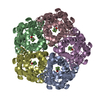+ Open data
Open data
- Basic information
Basic information
| Entry | Database: PDB / ID: 7mxy | |||||||||||||||||||||||||||
|---|---|---|---|---|---|---|---|---|---|---|---|---|---|---|---|---|---|---|---|---|---|---|---|---|---|---|---|---|
| Title | Cryo-EM structure of PfFNT-inhibitor complex | |||||||||||||||||||||||||||
 Components Components | Formate-nitrite transporter | |||||||||||||||||||||||||||
 Keywords Keywords | TRANSPORT PROTEIN/INHIBITOR / PfFNT / Lactate transporter / PfFNT-MMV007839 complex / TRANSPORT PROTEIN-INHIBITOR complex | |||||||||||||||||||||||||||
| Function / homology |  Function and homology information Function and homology informationhigh-affinity secondary active nitrite transmembrane transporter activity / lactate transmembrane transport / nitrite transport / lactate:proton symporter activity / vacuolar membrane / plasma membrane Similarity search - Function | |||||||||||||||||||||||||||
| Biological species |  | |||||||||||||||||||||||||||
| Method | ELECTRON MICROSCOPY / single particle reconstruction / cryo EM / Resolution: 2.18 Å | |||||||||||||||||||||||||||
 Authors Authors | Yu, E.W. / Su, C. / Lyu, M. | |||||||||||||||||||||||||||
| Funding support |  United States, 1items United States, 1items
| |||||||||||||||||||||||||||
 Citation Citation |  Journal: EMBO Rep / Year: 2021 Journal: EMBO Rep / Year: 2021Title: Structural basis of transport and inhibition of the Plasmodium falciparum transporter PfFNT. Authors: Meinan Lyu / Chih-Chia Su / James W Kazura / Edward W Yu /  Abstract: The intra-erythrocyte stage of P. falciparum relies primarily on glycolysis to generate adenosine triphosphate (ATP) and the energy required to support growth and reproduction. Lactic acid, a ...The intra-erythrocyte stage of P. falciparum relies primarily on glycolysis to generate adenosine triphosphate (ATP) and the energy required to support growth and reproduction. Lactic acid, a metabolic byproduct of glycolysis, is potentially toxic as it lowers the pH inside the parasite. Plasmodium falciparum formate-nitrite transporter (PfFNT), a 34-kDa transmembrane protein, has been identified as a novel drug target as it exports lactate from inside the parasite to the surrounding parasitophorous vacuole within the erythrocyte cytosol. The structure and detailed molecular mechanism of this membrane protein are not yet available. Here we present structures of PfFNT in the absence and presence of the functional inhibitor MMV007839 at resolutions of 2.56 Å and 2.78 Å using single-particle cryo-electron microscopy. Genetic analysis and transport assay indicate that PfFNT is able to transfer lactate across the membrane. Combined, our data suggest a stepwise displacement mechanism for substrate transport. The PfFNT membrane protein is capable of picking up lactate ions from the parasite's cytosol, converting them to lactic acids and then exporting these acids into the extracellular space. | |||||||||||||||||||||||||||
| History |
|
- Structure visualization
Structure visualization
| Movie |
 Movie viewer Movie viewer |
|---|---|
| Structure viewer | Molecule:  Molmil Molmil Jmol/JSmol Jmol/JSmol |
- Downloads & links
Downloads & links
- Download
Download
| PDBx/mmCIF format |  7mxy.cif.gz 7mxy.cif.gz | 452.1 KB | Display |  PDBx/mmCIF format PDBx/mmCIF format |
|---|---|---|---|---|
| PDB format |  pdb7mxy.ent.gz pdb7mxy.ent.gz | 380.1 KB | Display |  PDB format PDB format |
| PDBx/mmJSON format |  7mxy.json.gz 7mxy.json.gz | Tree view |  PDBx/mmJSON format PDBx/mmJSON format | |
| Others |  Other downloads Other downloads |
-Validation report
| Summary document |  7mxy_validation.pdf.gz 7mxy_validation.pdf.gz | 1.1 MB | Display |  wwPDB validaton report wwPDB validaton report |
|---|---|---|---|---|
| Full document |  7mxy_full_validation.pdf.gz 7mxy_full_validation.pdf.gz | 1.1 MB | Display | |
| Data in XML |  7mxy_validation.xml.gz 7mxy_validation.xml.gz | 41.9 KB | Display | |
| Data in CIF |  7mxy_validation.cif.gz 7mxy_validation.cif.gz | 62.4 KB | Display | |
| Arichive directory |  https://data.pdbj.org/pub/pdb/validation_reports/mx/7mxy https://data.pdbj.org/pub/pdb/validation_reports/mx/7mxy ftp://data.pdbj.org/pub/pdb/validation_reports/mx/7mxy ftp://data.pdbj.org/pub/pdb/validation_reports/mx/7mxy | HTTPS FTP |
-Related structure data
| Related structure data |  24076MC  6vqqC  6vqrC M: map data used to model this data C: citing same article ( |
|---|---|
| Similar structure data |
- Links
Links
- Assembly
Assembly
| Deposited unit | 
|
|---|---|
| 1 |
|
- Components
Components
| #1: Protein | Mass: 34492.281 Da / Num. of mol.: 5 Source method: isolated from a genetically manipulated source Source: (gene. exp.)  Strain: isolate 3D7 / Gene: PF3D7_0316600 / Production host:  Homo sapiens (human) / References: UniProt: O77389 Homo sapiens (human) / References: UniProt: O77389#2: Chemical | ChemComp-HV6 / ( #3: Water | ChemComp-HOH / | Has ligand of interest | Y | Has protein modification | N | |
|---|
-Experimental details
-Experiment
| Experiment | Method: ELECTRON MICROSCOPY |
|---|---|
| EM experiment | Aggregation state: PARTICLE / 3D reconstruction method: single particle reconstruction |
- Sample preparation
Sample preparation
| Component | Name: PfFNT-inhibitor complex / Type: COMPLEX / Entity ID: #1 / Source: RECOMBINANT |
|---|---|
| Source (natural) | Organism:  |
| Source (recombinant) | Organism:  Homo sapiens (human) Homo sapiens (human) |
| Buffer solution | pH: 7.5 |
| Specimen | Embedding applied: NO / Shadowing applied: NO / Staining applied: NO / Vitrification applied: YES |
| Vitrification | Cryogen name: ETHANE |
- Electron microscopy imaging
Electron microscopy imaging
| Experimental equipment |  Model: Titan Krios / Image courtesy: FEI Company |
|---|---|
| Microscopy | Model: FEI TITAN KRIOS |
| Electron gun | Electron source:  FIELD EMISSION GUN / Accelerating voltage: 300 kV / Illumination mode: FLOOD BEAM FIELD EMISSION GUN / Accelerating voltage: 300 kV / Illumination mode: FLOOD BEAM |
| Electron lens | Mode: BRIGHT FIELD |
| Image recording | Electron dose: 38 e/Å2 / Film or detector model: GATAN K3 BIOQUANTUM (6k x 4k) |
- Processing
Processing
| Software | Name: PHENIX / Version: 1.19_4080: / Classification: refinement | ||||||||||||||||||||||||
|---|---|---|---|---|---|---|---|---|---|---|---|---|---|---|---|---|---|---|---|---|---|---|---|---|---|
| EM software | Name: PHENIX / Category: model refinement | ||||||||||||||||||||||||
| CTF correction | Type: PHASE FLIPPING AND AMPLITUDE CORRECTION | ||||||||||||||||||||||||
| 3D reconstruction | Resolution: 2.18 Å / Resolution method: FSC 0.143 CUT-OFF / Num. of particles: 1044196 / Symmetry type: POINT | ||||||||||||||||||||||||
| Refine LS restraints |
|
 Movie
Movie Controller
Controller













 PDBj
PDBj



